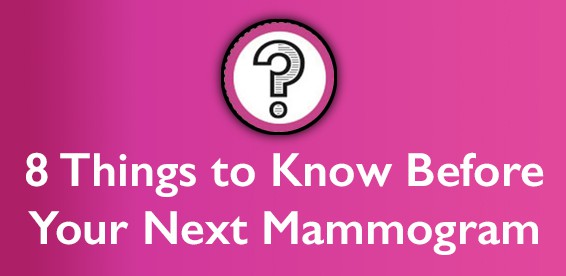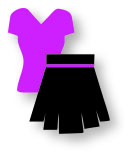 Having your first mammogram can seem intimidating. Women often hear stories that can be downright scary. To help calm fears and, hopefully, share the peace of mind that having a mammogram can bring, we’ve pulled together tips and answers to frequent questions about having your first – or annual – screening mammogram.
Having your first mammogram can seem intimidating. Women often hear stories that can be downright scary. To help calm fears and, hopefully, share the peace of mind that having a mammogram can bring, we’ve pulled together tips and answers to frequent questions about having your first – or annual – screening mammogram.
- Why Should I Get A Mammogram?
- When Do I Need To Have Mammograms?
- What Is A 3D Mammogram?
- What Should I Expect At My Mammogram?
- Does a Mammogram Hurt?
- How Do I Prepare For A Mammogram?
- How Much Radiation Is in a Mammogram?
- Can I Get A Mammogram If I Have Breast Implants?
Mammography is our best tool for detecting breast cancer — at its earliest possible stage. Breast cancer is the single most common cause of death in women ages 35 to 54. Having an annual mammogram, particularly a 3D mammogram, can help to find cancers and reduce deaths among women. In fact, finding breast cancer early reduces your risk of dying from the disease by 40%.
When you do get a mammogram, make sure your imaging office is accredited as a Breast Imaging Center of Excellence (BICOE) by the American College of Radiology. This designation is given to practices that meet excellence in all breast imaging procedures. All 14 of WakeRad UNC REX’s outpatient imaging offices have earned the BICOE designation.
 What’s The Difference Between 2D and 3D Mammograms?
What’s The Difference Between 2D and 3D Mammograms?
A 2D mammogram, also known as a traditional mammogram, is performed by compressing the breast and taking two images of each breast.
During a 3D mammogram, the x-ray arm sweeps over the breast in an arc and captures many more images from different angles. A computer then using those images to generate thin, 1 millimeter slices of your whole breast. This allows our breast imaging radiologists to move through the images as if they were ” flipping through a book” and see detail that can often be obscured on traditional mammogram images.
 When Do I Need To Have A Mammograms?
When Do I Need To Have A Mammograms?
WakeRad UNC REX’s breast imaging specialists are aligned with the current American College of Radiology (ACR) guidelines that recommend women have annual screening mammograms starting at age 40. We stand behind this recommendation even if you don’t have a family history of breast cancer.
![]() What Should I Expect At My Mammogram?
What Should I Expect At My Mammogram?
After checking in to any WakeRad UNC REX outpatient office, a certified technologist will guide you to dressing room where you’ll change into one of our pre-packaged, cloth gowns. Then, she will join you in a private exam room, explain the mammogram procedure and answer any questions you may have. She will help position your breast onto the platform where the 3D images will be taken. Once in proper position, your breast will be compressed for a few short seconds while the technologist quickly captures an image. As soon as the images are taken, the compression will be released.
After the exam is complete, the technologists will escort you back to your dressing room where you’ll change clothes and are free to go. There is no check out. A breast imaging radiologist will then review your mammogram images and compare them to any previous studies. WakeRad UNC REX will send your results to both you and your physician. If the radiologist needs additional images to clarify an area of concern, you will be contacted promptly.
Compression necessary to ensure a quality images. This part of your mammogram only lasts a few seconds and, contrary to popular belief, mammograms are not as uncomfortable as their reputation claims. If you’re worried about possible discomfort, follow these tips:
- Avoid scheduling your mammogram the week before your menstrual cycle when your breasts are most tender.
- If your breasts get tender after drinking caffeine, skip your morning cup of coffee the day of your mammogram.
- Take an over-the-counter pain reliever (like what you would take for a headache) an hour before your appointment.
- Relax. Your entire screening experience – from arrival to being back on your way – should only take about 30 minutes.
 How Should I Prepare For A Mammogram?
How Should I Prepare For A Mammogram?
There are several things you can do to ensure WakeRad UNC REX captures quality images and your mammogram goes as smoothly.
- Avoid wearing lotion, powder, deodorant or perfume on the day of your mammogram. These products can cause spots on your breast images.
- Wear a two-piece outfit, not a dress. Since you’ll wear a cloth gown into the exam room, you’ll only need to undress from the waist up.
- Pre-register online. We’ll collect all of your contact and insurance information upfront. When you arrive, just let us know and you can remain in your car until we text you that we’re ready to start your exam.
![]() Is There Radiation In a Mammogram?
Is There Radiation In a Mammogram?
Yes, but it’s extremely small. Today’s mammography equipment produces high quality breast images using low doses of radiation. The radiation dose a woman receives with a screening mammogram is about equal to the dose received over seven weeks from natural surroundings or background radiation. At WakeRad UNC REX, we do everything possible to reduce radiation for all patients.
Can I Get A Mammogram If I Have Breast Implants?
Yes – and we recommend that you do! Just let us know you have implants when you schedule your appointment and share this information with your technologists at the time of your exam. 3D mammograms have a specific setting for breast implants. 3D images of the breast are taken with breast tissue in front of the implant in addition to the regular images of the breast.
